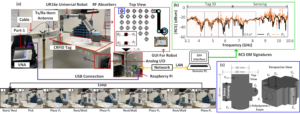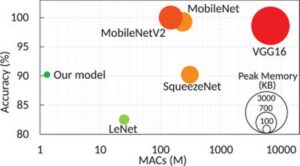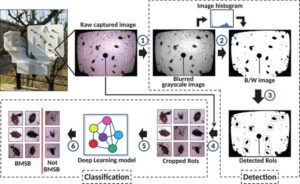The featured projects below provide an overview of some of the research at Tyndall in Wireless Communications and AI.

Tyndall’s Wireless Communications & AI Research programme is focused on addressing the critical research challenges needed to shape the future of wireless communication networks and edge AI.
Key Areas of Research:
- Hyper-Flexible Wireless Networks: Enabling intelligent, ultra-fast, and ultra-reliable low-latency connectivity across the human, physical, and digital worlds.
- AI Algorithms & Digital Twins: Developing future AI algorithms that enable the automatic creation of digital twins for efficient, real-time learning with minimal data. These innovations aim to reduce manual configuration and solve complex, universal problems across industries.
- Co-Designing Hardware for Extreme Edge AI: Creating hardware enablers, including programmable radio frontends and novel brain-inspired AI ASICs, that support AI and wireless network operations.
Transforming the Future of Wireless & AI:
Our research is creating innovations that deliver 10-100x improvements in key areas such as AI and real-time applications. This research is not only setting the stage for next-generation IoT communications, Wi-Fi, 5G, 6G, and beyond but also enabling accessibility for humans and machines anywhere. Through collaborations with industry partners and the creation of high-value startups, we are making a global impact.
Our Mission:
Our mission is to drive scientific advancements at the intersection of Future Networks and AI. We focus on the co-design of algorithms and hardware to enable instant and reliable access to information, computing resources, and AI for users everywhere. We work closely with industry leaders to translate our findings into tangible solutions that benefits both societal and commercial impact.
Industry & Policy Engagement:
By working closely with industry leaders, we aim to translate cutting-edge research into impactful solutions for industries ranging from telecommunications, sensing, autonomous vehicles and drones, industrial automation, to healthcare and smart infrastructure, fostering technological advancement and societal benefits. Engagement models include direct funded projects, Enterprise Ireland funded schemes, Research Ireland projects and various EU funded mechanisms.
We actively contribute to European AI policy whitepapers and technology innovation roadmaps through our participation in platforms like EPoSS and AIOTI. Additionally, we are shaping the future of AI in networks through EU projects like 6G-XCEL.
Research Challenges:
AI and wireless networks are central to modern life, enabling constant connectivity and access to sophisticated services. As AI relies on wireless networks for data exchange and processing, the evolution of 6G networks will increasingly depend on AI to optimise their operations. To continue advancing these vital technologies, our research team is tackling the following key challenges to enable the future of seamless connectivity and intelligent systems.

Hyperflexible Wireless Networks:
To achieve a 10-100x performance leap, future networks must become more specialised. Historically, specialisation has been costly, leading to a 10-year innovation cycle between network generations (3G, 4G, 5G) for economies of scale. Tyndall is developing Hyper-flexible AI-defined networks that are fully programmable, from RF hardware, Physical and MAC Layer, to communication protocols, allowing adaptation to extreme requirements cost-effectively. This enables next-gen services like holographic communication, remote control of robots and drones, medical devices, connected implants, as well as sensing and localisation.

Fundamental Advances in AI Techniques:
AI has moved from labs to the real world and is now being applied across a wide range of sectors and industries globally. However, challenges like high energy consumption, the need for manual fine-tuning, poor robustness, and trial-and-error during the learning process are limiting its application, particularly for resource-constrained use cases, such as those at the extreme edge. We are working on creating efficient learning at the edge with limited data, using novel AI techniques that combine neural networks with the genetic evolution of algorithms, bringing together the best of biological and traditional computation, as well as using digital twins to enable online learning without disruptions. This will unlock the potential for a wide array of new AI applications, including fully autonomous cars and robots, material discovery and manufacturing, telemedicine, and the next generation of wireless networks.
Co-Designing Hardware Enablers for Wireless and AI at the Extreme Edge:
Advances in Wireless Communications and AI depend on the co-design of hardware enablers. In wireless communications, we are developing programmable radio frontend hardware as a key enabler for AI-defined networks. This includes programmable filters, antennas, antenna arrays, and RF surfaces, made possible by novel reconfigurable materials engineered for optimal switching characteristics, enabling reconfigurable RF-to-sub-THz wave front ends. In AI, we are creating custom AI ASICs based on neuromorphic computing and hardware accelerators to drastically improve energy efficiency and accelerate novel AI techniques.
Projects
Hyperpath | Reliable & Secure Connectivity Anywhere
In the Enterprise Ireland Commercialisation Fund project HyperPath, we enable combining multiple unreliable wireless links into an ultra-reliable low latency connection. This is achieved through a patent-pending P2P multi-connectivity architecture to minimise latency and cloud costs, novel multi-path replication and aggregation protocols, that is easily deployable as a user space application. This functionality is a key enabler for beyond visual line of sight connectivity for drones (UAVs/UGVs), Industry 4.0, connectivity for future medical devices and other applications that require reliable connectivity anywhere. We presented HyperPath at Mobile World Congress in Barcelona in 2024 and are currently trialing with several unmanned Aerial and Ground Vehicle companies across Europe, with the intention of creating a spinout company in 2024.
“Connectivity is critical for the operation of our fleet. If connectivity drops our customers’ business is negatively impacted, this must not happen. HyperPath uniquely solves this critically important problem for us” — Mike Potts, Founder & CEO, Street Drone.
Click here for more information.

DTIF GUARD | Drug Interdiction Using Smart Drones
The Disruptive Technologies Innovation Fund project GUARD will create a new smart autonomous drone system with the aim of helping the Irish Navy cost-effectively monitor Ireland’s large coastline to prevent drug smuggling into Ireland and the EU. The GUARD solution will be a leap in capability, compared to the state-of-the-art, able to operate fully autonomously in harsh weather conditions with 800 km range, support vertical take-off and landing from both ships and shore, automatic creation of flight plan and permissions for operation in civil airspace, automatic creation of a digital twin of survey area & AI based video analysis, gigabit mm-wave communications & reliable low latency multi-connectivity, and VR control enabling intuitive ‘human in the loop’ high value decision making. The capability will be demonstrated in collaboration with the Irish Navy and position Ireland as a leader in autonomous drone technology, a market that will grow by 15.5% annually to $45.8bn by 2025.
Click here for more information.

MISTRAL | Improving Communications Capabilities of the Irish Defence Forces
The MISTRAL project aims at improving the Very High Frequency (VHF) communications capability of the Irish Defence Forces. We address the problem through drone-based VHF relaying, AI based creation of a coverage prediction model-based path-loss measurements during the flight, and a pro-active drone coverage optimisation that anticipates changes in user locations and maximises coverage for both single and multiple drone deployments. We have demonstrated a game-changing 625x coverage improvement validated by real field measurements. MISTRAL won a EUR 500k prize in the SFI-Defence Organisation Innovation Challenge 2023.
“One of the biggest force multipliers that we could have is a way of having information fed back in a more real time way.” — Sgt. Paul Brady, Communication Information Systems (CIS) corps, Irish Defence Forces.
6G-XCEL | AI Solutions for 6G Networks
The EU project 6G-XCEL will bring together a large ecosystem of researchers from the EU and US to implement elements of the DMMAI framework in their testbeds and labs. DMMAI (Decentralized Multi-party, Multi-network AI) is a reference framework for AI in 6G that will pave the way towards global validation, adoption, and standardization of AI approaches. This framework will enable the federation of AI-based network controls across network domains and physical layers, while promoting security and sustainable implementations. Research on the resulting decentralized multi-party, multi-network AI (DMMAI) framework will enable the development of reference use cases, data acquisition and generation methods, data and model repositories, curated training, and evaluation data, as well as technologies and functionalities for its use as a benchmarking platform for future AI/ML solutions for 6G networks.
Click here for more information.


ENTICE | Filter and Antenna Modules for 5G and 6G Hardware
In the Enterprise Ireland Commercialisation Fund project ENTICE, we aim to develop filters and antenna-in-package (AiP) modules that will meet the challenging specifications at mm-wave frequencies (28 GHz) and upper mm-wave frequencies (D-band frequencies are in the range from 110 GHz to 170 GHz), which will be showcased to our target customers. These modules are based on Tyndall owned technology (Split-Concentric-Ring Resonator) with a patent pending which, in conjunction, with cost effective manufacturing techniques will produce world-leading 5G and 6G hardware. The filter and antenna modules produced through ENTICE will be of a very low profile, approximately 10 times smaller than the equivalent standard technologies. We expect to create a spinout company commercialising this technology in 2026.

RENAISSANCE | Wireless Charging of IoT Devices
The SFI’s National Challenge Fund project entitled RENAISSANCE is concerned with in-situ wireless charging/powering of IoT devices based on the concept of magnetic coupling, requiring no removal of IoT sensors/devices from their current position. The crux of the project lies with treating the room, office or a factory floor as a natural microwave resonator with IoT sensors/devices placed inside it. In this way, the room/office or a factory floor could be used as a natural amplifier of the magnetic fields used to charge/power IoT devices. In doing so, RENAISSANCE will:
- Obviate the need for battery replacement and their disposal, having an immediate positive environmental and economic impact; (2) reduce the energy needs required for battery production.
- Reduce the energy needs required for battery production through the provision of wireless charging/powering of IoT devices.
- Provide a safe and uninterrupted source of wireless power to the IoT sensor without any sensor down-time.

AI for CRFID
Passive Radio Frequency Identification technology (RFID) has been a key wireless communication technology enabling IoT. Recent advances have paved the way for battery-less, chipless Radio Frequency Identification (CRFID), which eliminates the need for an integrated circuit (IC) component on the tag. This project introduced a novel design strategy for concentric rings-based polarisation-insensitive CRFID sensing tags, enhancing data encoding capacity by 88.2% compared to conventional designs. Implementing Radar Cross Section (RCS) nulls for data encoding enables accurate sensing by the innermost ring, with an additional outermost ring aiding robust detection. Artificial Intelligence (AI) is integrated on the reader side, employing machine learning (ML) and deep learning (DL) techniques for decoding RCS EM signatures. ML/DL models generalise well, with 1D-CNN DL models outperforming conventional ML models in ID and sensing value detection. Additionally, a 3-bit depolarising CRFID tag is developed and enabled for surface and shape robust detection using AI, achieving low normalised RMSE values (0.48%) for tag ID detection. These contributions significantly advance AI-enabled CRFID systems for robust IoT applications.

Parkinson’s Precision Diagnosis via Wearable Sensors
The objective of this project is to create a highly miniaturised wearable device for precise Parkinson’s Disease (PD) diagnosis, incorporating robust machine learning algorithms validated through informal clinical research. This innovative system aims to revolutionise healthcare provision and cost containment by developing novel algorithms for advanced PD diagnosis, utilising wrist and ankle devices to capture inertial, photoplethysmograph, and electrocardiogram data. Collaboration with PD patients and an industrial design partner ensures acceptability and wearability of the developed solution. The system comprises wrist and ankle devices to record accelerations, angular velocities, photoplethysmograph, and electrocardiogram data, enabling offline analysis for motor symptoms, gait speed, sleep-wake cycles, and cuff-less blood pressure measurements. Additionally, a novel algorithm for advanced PD assessment addresses challenges in objectively evaluating motor symptoms during daily activities, distinguishing them from medication side effects. The system demonstrates feasibility in detecting symptom episodes in real-life scenarios, representing a significant advancement in PD diagnosis and management. The team won the AI Awards Ireland 2023 (Category: “Best Application of AI in an Academic Research Body”) for this project.
Click here for more information on the Annual AI Ireland Awards.

Using a Low Power Edge Based Monitoring System for Insect Monitoring
Smart monitoring systems in orchards can automate agriculture monitoring processes and provide useful information about the presence of insects, such as the Brown Marmorated Stink Bug (BMSB), that threaten the production quantity and quality of fruit such as pears. Unlike other approaches in the literature, this project proposed a low-cost image monitoring system which exhibits a very low power consumption without compromising much of the accuracy that existing expensive systems, of which incorporate significant computing and processing capability, can achieve in such applications. The proposed system relies on a microcontroller unit and a camera which can take pictures of a double-sided sticky insect trap which, with the help of novel machine learning algorithms, can report on the presence of BMSB via a long-range communication link. The Internet of Things data capture and analysis system has recently been deployed in a real orchard in Italy which is subject to BMSB infestation and the first images have been analysed. The system achieves an accuracy of over 90% with multiple times less memory and energy consumption compared to other similar approaches in the literature.
Click here for more information.


Recent Publications
2025
Reliability and Latency Analysis of UAV-Assisted Base Station With Differentiated 5G Services“ Prasanna Raut, Boris Galkin, Debashisha Mishra, Enrico Natalizio, IEEE Wireless Communications and Networking Conference (WCNC) Workshops 2025
Entanglement Request Scheduling in Quantum Networks Using Deep Q-Network, Gongyu Ni, Lester Ho, Holger Claussen, 2025 IEEE International Conference on Communications
S. G. Padder, J. Ambulkar, A. Banotra, S. Modem, S. Maheshwari, K. Jayaramulu, and C. Kundu, “Data-driven approaches for estimation of EV battery SoC and SoH: A review,” IEEE Access, vol. x , pp. xx – xx, Jan. 2025. (Accepted)
2024
V. Kirillov, D. Kozlov, H. Claussen and S. Bulja, “In-Vessel Resonant Communications“, IEEE Access, (2024).
L. Antony, A. Zandamela, N. Marchetti and A. Narbudowicz, “Virtual Spherical Modes for AoA Estimation with Small Sub-Wavelength Antennas,” in IEEE Antennas and Wireless Propagation Letters
“Experimental Evaluation of a Low-Cost UAV-Based System for Locating Ground Transmitters” by Boris Galkin, Lester Ho, Paul Brophy and Holger Claussen accepted to the Vehicular Technology Conference Fall 2024.
Adam Narbudowicz – “On Switch Network Topologies for mm-Wave Beam-Switching Antenna”, has been accepted for inclusion in the programme of EuCAP 2025 (Stockholm, Sweden, 30 March – 4 April 2025)
S. B. Kotwal, C. Kundu, S. Modem, H. Claussen, and L. Ho, “Multi-task Learning-based Joint CSI Prediction and Predictive Transmitter Selection for Security,” in Proc. IEEE Global Communications Conference (GLOBECOM 2024)-Workshops, Cape Town, South Africa, 8-12 Dec. 2024.
2023
B. Galkin, L. Ho, K. Lyons, G. Celik and H. Claussen, “Experimental Evaluation of Air-to-Ground VHF Band Communication for UAV Relays“, IEEE International Conference on Communications Workshops (ICC Workshops), Rome, Italy, pp. 1428-1432, (2023).
B Galkin, L Ho, K Lyons, G Celik, H Claussen “Experimental Evaluation of Air-to-Ground VHF Band Communication for UAV Relays“ Accepted IEEE International Conference on Communications (ICC) 2023, Workshop on Integrating UAVs into 5G and Beyond
Babatunji Omoniwa, Boris Galkin and Ivana Dusparic, “‘Density-Aware Reinforcement Learning to Optimise Energy Efficiency in UAV-Assisted Networks”, 2023 19th International Conference on Wireless and Mobile Computing, Networking and Communications (WiMob)
Lorenzo Bellone, Boris Galkin, Emiliano Traversi and Enrico Natalizio, “Deep Reinforcement Learning for Combined Coverage and Resource Allocation in UAV-Aided RAN-Slicing”, 5th International Workshop on Wireless Sensors and Drones in Internet of Things (Wi-DroIT) 2023
Dmitry Zelenchuk, Vitalii Kirillov, Camilla Kärnfelt, Francois Gallée, Irina Munina Metamaterial-based LTCC Compressed Luneburg Lens Antenna at 60 GHz for Wireless Communications , MDPI electronics – submitted
Ciara McDonald, Holger Claussen, Ronan Farrell, and John Dooley, “FPGA implementation of a sub-400ns 6G free-space optical wireless communications transmitter,” Opt. Express 31, 25933-25942 (2023)
Galkin, B. “Communication-Enabled Deep Reinforcement Learning to Optimise Energy-Efficiency in UAV-Assisted Networks”, published in Vehicular Communications. https://www.sciencedirect.com/science/article/pii/S2214209623000700
“Performance Estimation of In-Vessel Resonant Communications” Vitalii Kirillov, Dmitry Kozlov, Senad Bulja, Holger Claussen. Submitted to EUCAP
“Learning-assisted User Scheduling and Beamforming for mmWave Vehicular Networks“ in: IEEE Transactions on Vehicular Technology, Boris Galkin
C. D. Bui, A. Quinn, D. Iacopino and A. Narbudowicz, “Compact Chipless RFID Sensor for Frozen Food Monitoring,” in IEEE Sensors Journal, doi:10.1109/JSEN.2024.3378678.
Contactless Moisture Content Sensor Based on Wheeler Cap for Waste-to-Energy Plants, IEEE Open Journal on Antennas and Propagation: PRAKORN PRATOOMMA, ADAM NARBUDOWICZ, SURAMATE CHALERMWISUTKUL, IEEEhttps://ieeexplore.ieee.org/stamp/stamp.jsp?tp=&arnumber=10620316
2022
S. Bulja, R. Kopf, A. Tate, M. Cappuzzo, D. Kozlov, H. Claussen, D. Wiegner, W. Templ, D.M. Syahkal, “High frequency resistive switching behavior of amorphous TiO2 and NiO“, Scientific Reports 12 (1), 1-16, (2022).
TM Pham, R Farrell, H Claussen, MF Flanagan, LN Tran, “On the MIMO Capacity With Joint Sum and Per-Antenna Power Constraints: A New Efficient Numerical Method,” IEEE Transactions on Vehicular Technology 71 (9), 10179-10184, 2022
S Bulja, H Claussen, D Kozlov, I Munina, P Turalchuk, “Ceramic‐elements‐based distributed resonators and filters ,” Electronics Letters 58 (3), 109-111, 2022
KK Nguyen, TQ Duong, T Do-Duy, H Claussen, L Hanzo, “3D UAV trajectory and data collection optimisation via deep reinforcement learning ,” IEEE Transactions on Communications 70 (4), 2358-2371
V. Kirillov, D. Kozlov, P. Rulikowski and S. Bulja, “Beamforming network based on novel continuously tunable couplers”, in IEEE Access, vol.10, 2022
S. Bulja, D. Kozlov, M. Norooziarab, R. Cahill, R. Kopf, M. Cappuzzo, A. Tate, W. Templ and D. Wiegner, “Electrochromic materials and their use for telecommunications applications (review)”, invited, 19th RIA/URSI Research Colloqium on Radio Science and Communications, Dublin, Ireland (Oct. 2022)
M. Norooziarab, S. Bulja, R. Cahill, R. Kopf, M. Cappuzzo and A. Tate “Electro Chromic-based unit cell for millimetre-wave reconfigurable reflectarrays”, in IEEE International Workshop on Antenna Technology (iWAT, 2022)
M Norooziarab, S Bulja, D Kozlov, R Kopf, M Cappuzzo, A Tate,R Cahill, “Nonlinear Measurements of ElectrochromicWO3/LiNbO3/NiO at Microwave Frequencies,” Accepted, 8th IEEE RADIO – ConfTool

